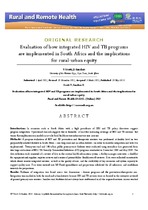| dc.description.abstract | Introduction: In countries such as South Africa with a high prevalence of HIV and TB policy directives support program integration. Operational research suggests this is desirable, at least for increasing coverage of HIV and TB services, but warns that implementation models must take local health service infrastructure into account.
Methods: A program evaluation of HIV and TB prevention and therapeutic services was performed at facility level in two purposefully selected districts in South Africa – one deep rural and an urban district – in order to describe integration and how it is implemented. Twenty-six rural and 146 urban public primary-care facilities were evaluated using secondary data generated from two large evaluations of HIV/TB/Sexually Transmitted Infections (STI) programs conducted in December 2008 and May 2009. The data collection tools consisted of a review of data in the routine health information system, a facility manager interview, a checklist for equipment and supplies, register reviews and a series of patient folder (health record) reviews. Data were collected on extent to which clients receive integrated services, as well as the quality of care, and the availability of key resources and system capacity to support quality care. Data were entered into MS Excel spreadsheets and proportions calculated for all indicators, and confidence intervals for proportions. Results: Evidence of integration was found across two dimensions - disease programs and the prevention–therapeutic axis. Integration was enabled in both the rural and urban districts because HIV and TB services were co-located in the extensive network of general primary-care services. Smaller rural facilities did not always have staff trained in all the required services, nurses worked without the support of a doctor and supervision was weaker, threatening quality of care. In the rural district there were instances of clients receiving more integrated services. The quality of care in the TB program was high in both districts. Conclusions: In both the districts evaluated, integration across programs and the prevention-care-rehabilitation axis of services was achieved through co-location at primary-care level. Coupled with health system strengthening, this has the potential to improve access across the HIV/TB/STI cluster of services. The benefit is likely to be greater in rural areas. Quality of care was maintained in the long established TB programs in both settings. | en_US |

